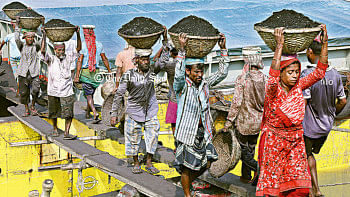The shredding of Banksy's painting

On October 5, during an auction in London, a painting called "Girl With Balloon" by a famous yet mysterious British "graffiti" artist called "Banksy" was purchased by an unknown woman for USD 1.4 million which shred itself (the shredder was hidden inside the frame) into pieces right after the sale, surprising the world. All spotlights are now on Banksy and his shredded piece of art. Everybody is trying to grasp the message behind this act. What was the reason for this arrogant show of disrespect towards a USD 1.4 million sale which was a record for Banksy's art?
One key feature of our global market economy is that the market needs to continuously provide new products and services to a wide range of consumers. There has to be continuous transactions, exchange of goods and services as money must change hands for the economy to stay vibrant. People have to work, produce, sell, earn, spend, purchase, consume, borrow and repay. The US used to be, and still is, the greatest example of free market economy, being one of the largest exporters, importers and economy in the world with the largest deficit.
People and organisations with massive wealth need exclusive products to invest in that have the potential to give unthinkable returns compared to ordinary financial instruments. One of these very highly priced products are paintings. There is a nexus of artists whose works are branded as "exceptional" by a well-controlled circle of "critics", some of their works are promoted as high quality "works of art" by these "critics" and their host organisations. People and organisations (e.g. international banks) with huge idle money usually purchase these during highly publicised auctions.
The shredding of "Girl With Balloon" by Banksy just at the precise moment of being sold forced people around the world to rethink the state of the artworld—whether positively or negatively.
One expert commented that "Banksy didn't destroy an artwork in the auction, he created one." Even Banksy himself wrote in the caption: "Going, going, gone..." when he posted an Instagram picture of shocked attendees watching the painting disintegrate. The Sotheby auction house was very innovative in naming the shredded piece left in the bin as "Love is in the Bin", and offered an authenticated certificate with the new title. Even the buyer wished to honour the purchase and collect the shredded piece saying it is "my own piece of art history". It was a business success despite the extraordinary act of destruction. All was managed well and there is potential for the price of the shredded piece to increase further in future.
Banksy has become somewhat of a mystery figure in the last 20 years as a global graffiti artist. He has travelled to many countries and left the graffiti world with philosophical and political messages. His nine graffiti arts on the Bethlehem Walls in Israel left some very strong messages. His graffiti of a young protester "throwing a flower bouquet" is mesmerising. His graffiti of "Dove in the bullet proof vest and olive branch in its beak" speaks louder than a thousand words.
People couldn't stop nodding when Banksy's graffiti showed Trump thinking "I am going to build you a brother" touching the "Bethlehem wall" in a Jewish cap. Banksy is a contemporary artist. His graffiti of "Mobile Lovers" depicts lovers looking at their phones while hugging each other. His New York graffiti attracted the entire world's attention. Banksy wrote, "Keep your coins I WANT CHANGE" on a signboard held by a street beggar. He had shown a physician checking the heart of NY where the graffiti read "I Love NY"—the word "love" is not written but drawn. Blood coming out of a distorted red telephone booth on a footpath in London definitely reflects the romantic feeling of many of his countrymen. In one important work, Banksy wrote, "Sorry! The lifestyle you ordered is currently out of stock."
Because his graffities highlight important global issues, they are well respected by many around the world. As a result, the "Banksy effect" seems to have gone global, touching even Dhaka's graffiti scene it seems. Banksy used his "Girl With Balloon" on at least two other graffities. In one, he wrote, "No Future" where the letter "O" with a balloon was tied to a string that was held by a girl. In another, he showed a girl trying to cross a wall using a few gas balloons. It is possible that he was using the girl and the balloon to symbolically represent the constant aspirations of humans to achieve freedom from physical boundaries or mental oppression and especially from the suppression of speech. Thus his effort to shred the "Girl With Balloon" could be regarded as his attempt to free the piece of art from the custody of the collector.
In Dhaka we have an unknown graffiti artist named "Hobeki". His graffiti can be found in a few places where he expresses his pain of oppression and the suppression of ordinary people's freedom of expression. He has a series on "Shubodh" where he depicts a caged "Sun". The question is, why has it attracted the attention of so many people. Is it because "Shubodh" represents the struggle that they themselves now face?
ASM Shahidul Haque is a development worker. Email: shahidulhaque@gmail.com


 For all latest news, follow The Daily Star's Google News channel.
For all latest news, follow The Daily Star's Google News channel. 



Comments